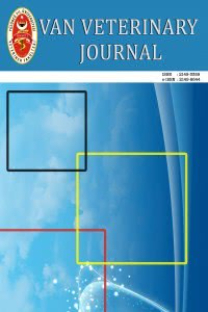Serum zinc, copper and thyroid hormone concentrations in heifers with retarded growth
çinko, hayvan fizyolojisi, büyüme geriliği, düve, tiroid hormonları, somatotropin, dişi hayvanlar, yemden yararlanma, bakır
Gelişme geriliği gösteren düvelerde serum çinko, bakır ve tiroid hormon konsantrasyonları
zinc, animal physiology, growth retardation, heifers, thyroid hormones, somatotropin, female animals, feed conversion efficiency, copper,
___
1. Abba M., De Luca JC, Mattioli G, Zaccardi E, Dulout FN (2000): Clastogenic effect of copper deficiency in cattle. Mutat Res. 466: 51-55.2. Akkan HA (2000): The relationship between hair loss and thyroid hormones in Van Cats. Univ. Yuzuncu Yil, Health Science Institute, PhD Thesis, Van, Turkey.
3. Camas H, Bildik A, Gülser F (1998): Studies on the amount of zinc in soil, plant and blood of sheep. I. National Zinc Congress, Eskisehir, Turkey, pp:637-641.
4. Cerci IH, Sahin K, Gurdogan F, Sahin N, Erkal N (1998): Studies on the status of zinc in cattle nutrition in the region of Elazıg. I. National Zinc Congress, Eskisehir, Turkey, pp: 625-628.
5. Corrigall W, Dalgarno AC, Ewen LA, Williams RB (1976): Modulation of plasma copper and zinc concentrations by disease states in ruminants. Vet. Rec. 13: 396-397.
6. Dargatz DA, Garry FB, Clark GB, Ross PF (1999): Serum copper concentrations in beef cows and heifers. JAVMA. 215: 1828-1832.
7. Ellenberger MA, Johnson DE, Cartsens GE, Hossner KL, Holland MD, Nett TM, Nockels CF (1989): Endocrine and metabolic changes during altered growth rates in beef cattle. J. Anim. Sci. 67: 1446-1454.
8. Fraker PJ, Gershwin ME, Good RA, Prasad RA (1986): Interrelationships between zinc and immune function. Federation Proceedings 45: 1474-1479.
9. Fraser CM, Bergeron JA, Mays A, Aiello SE (1991): The Merck Veterinary Manual, Seventh Ed., Merck and Co. Inc. USA.
10. Guyton AC (1986): Textbook of Medical Physiology, Seventh Ed., Nobel Medicine Bookstore, Istanbul.
11. Harvey WR (1987): Users guide for LSMLMWPC-1 version mixed model least squares and maximum likelihood computer programme. Ohio State University, Colombus.
12. Hornick JL, Van Eenaema C, Diez M, Minet V, Istasse L (1998): Different period of feed restriction before compensatory growth in belgian blue bulls: II. Plasma metabolities and hormones. J. Anim. Sci. 76: 260-271.
13. Jonathan M, Sarah L (1991): Large Animal Clinical Nutrition. Mosby Year Book, USA.
14. Mert N (1996): Veterinary Clinical Biochemistry. Ceylan Typography Ltd. Bursa.
15. Rodastits OM, Blood DC, Gay CC (1991): Veterinary Medicine. A textbook of the diseases of cattle, sheep, pigs, goats and horses. Bailliere Tindall, London.
16. Ulutas Z, Akbulut O, Tuzmen N, Ozturk A (1996): Growth and Development in DAK calves weined in different period. Journal of Lalahan Livestock Research Institute 36: 54-67.
17. Underwood EJ: The mineral nutrition of livestock, Second Ed. Farnham Royal, Commonwealth Agricultural Bureaux, London.
18. Wiske SE, Herd D, Field D, Holland P (1992): Diagnosis of copper deficiency in cattle. JAVMA. 200: 1625- 1629.
19. Yılmaz B (1999): Hormones and Reproduction Physiology. Feryal Typography, Ankara.
- ISSN: 1017-8422
- Yayın Aralığı: 3
- Başlangıç: 1990
- Yayıncı: Yüzüncü Yıl Üniv. Veteriner Fak.
Nutrient and botanical composition of pasture in Ceylanpınar Agriculture Farm
MEHMET AVCI, OKTAY KAPLAN, Mugdat YERTÜRK, MUSTAFA ASLAN
Dose dependent effectiveness of topical selamectin on puppies with ascaridiosis
Nazmi YÜKSEK, NURİ ALTUĞ, ABDULLAH KAYA, Tevfik Zahid AĞAOĞLU, Yaşar GÖZ, CUMALİ ÖZKAN
Hindi lenfoid organlarında (Timus, ve Bursa Fabricius) yaşa bağlı olarak mast hücrelarinin dağılımı
Turan KARACA, MECİT YÖRÜK, SEMA USLU
Serum zinc, copper and thyroid hormone concentrations in heifers with retarded growth
